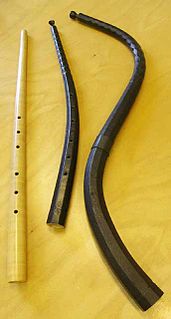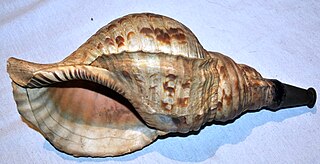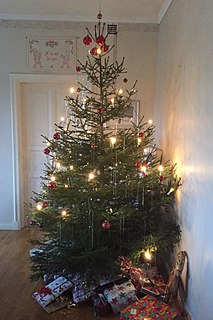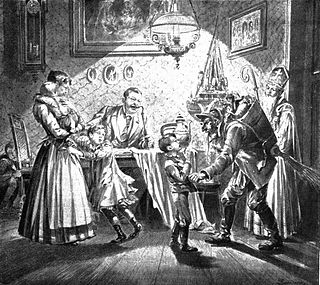
The alphorn or alpenhorn or alpine horn is a labrophone, consisting of a straight several-meter-long wooden natural horn of conical bore, with a wooden cup-shaped mouthpiece. It is used by mountain dwellers in the Swiss Alps, Austrian Alps, Bavarian Alps in Germany, French Alps, and elsewhere. Similar wooden horns were used for communication in most mountainous regions of Europe, from the Alps to the Carpathians. Alphorns are today used as musical instruments.

Yule or Yuletide is a festival historically observed by the Germanic peoples. Scholars have connected the original celebrations of Yule to the Wild Hunt, the god Odin, and the pagan Anglo-Saxon Mōdraniht.

The cornett, cornetto, or zink is an early wind instrument that dates from the Medieval, Renaissance and Baroque periods, popular from 1500 to 1650. It was used in what are now called alta capellas or wind ensembles. It is not to be confused with the trumpet-like cornet.

A lur, also lure or lurr, is a long natural blowing horn without finger holes that is played by embouchure. Lurs can be straight or curved in various shapes. The purpose of the curves was to make long instruments easier to carry and to prevent directing the loud noise at nearby people.

Sinterklaas or Sint-Nicolaas is a legendary figure based on Saint Nicholas, patron saint of children. Other names for the figure include De Sint, De Goede Sint, and De Goedheiligman in Dutch; Saint Nicolas in French; Sinteklaas in West Frisian; Sinterklaos in Limburgs; Saint-Nikloi in West Flemish; Kleeschen and Zinniklos in Luxembourgish; and Sankt Nikolaus or Nikolaus in German.

Saint Nicholas Day, also called the Feast of Saint Nicholas, is observed on the 6th of December or on the eve of the 5th of December in Western Christian countries, and on the 19th of December in Eastern Christian countries using the old church Calendar. It is the feast day of Nicholas of Myra with particular regard to his reputation as a bringer of gifts.

The tenor saxophone is a medium-sized member of the saxophone family, a group of instruments invented by Adolphe Sax in the 1840s. The tenor and the alto are the two most commonly used saxophones. The tenor is pitched in the key of B♭ (while the alto is pitched in the key of E♭), and written as a transposing instrument in the treble clef, sounding an octave and a major second lower than the written pitch. Modern tenor saxophones which have a high F♯ key have a range from A♭2 to E5 (concert) and are therefore pitched one octave below the soprano saxophone. People who play the tenor saxophone are known as "tenor saxophonists", "tenor sax players", or "saxophonists".
The central and eastern Alps of Europe are rich in folklore traditions dating back to pre-Christian times, with surviving elements originating from Germanic, Gaulish (Gallo-Roman), Slavic (Carantanian) and Raetian culture.

Twente is a non-administrative region in the eastern Netherlands. It encompasses the most urbanised and easternmost part of the province of Overijssel. Twente is most likely named after the Tuihanti or Tvihanti, a Germanic tribe that settled in the area and was mentioned by the Roman historian Tacitus. The region's borders are defined by the Overijssel region of Salland in the northwest and west, the German County of Bentheim in the northeast and east and the Gelderland region of the Achterhoek in the south.

A pipe is a tubular wind instrument in general, or various specific wind instruments. The word is an onomatopoeia, and comes from the tone which can resemble that of a bird chirping.

Horagai (法螺貝) are large conch shells, usually from Charonia tritonis, that have been used as trumpets in Japan for many centuries. The instrument, which has served a number of purposes throughout Japanese history, has been given a number of Japanese names depending on its function. Special schools still teach students to play the traditional music associated with the conch.

A friction drum is a musical instrument found in various forms in Africa, Asia, Europe and South America. In Europe it emerged in the 16th century and was associated with specific religious and ceremonial occasions.

Jul or jol is the term used for the Christmas holiday season in Scandinavia and parts of Scotland. Originally, "jul" was the name of a month in the old Germanic calendar. The concept of "jul" as a period of time rather than a specific event prevailed in Scandinavia; in modern times, "Jul" is a period of time stretching from mid-November to mid-January, with Christmas and the week up to New Year as its highlight. The modern English yule and yuletide derive from this term.
The chromatic trumpet of Western tradition is a fairly recent invention, but primitive trumpets of one form or another have been in existence for millennia; some of the predecessors of the modern instrument are now known to date back to the Neolithic era. The earliest of these primordial trumpets were adapted from animal horns and sea shells, and were common throughout Europe, Africa, India and, to a lesser extent, the Middle East. Primitive trumpets eventually found their way to most parts of the globe, though even today indigenous varieties are quite rare in the Americas, the Far East and South-East Asia. Some species of primitive trumpets can still be found in remote places, where they have remained largely untouched by the passage of time.

The birch trumpet is a type of natural trumpet made of spruce covered with birch bark, known in Norway, Sweden, Finland, England, Denmark, Latvia, Lithuania, Belarus and Estonia. Even cruder and less durable versions were made of plain birch bark. They are associated with the early European Chalet culture, where it was presumably used to intimidate predators, frighten supernatural enemies, and convene council meetings.

Christmas is celebrated throughout December and traditionally until St. Knut's Day on January 13. The main celebration and the exchange of gifts in many families takes place on Christmas Eve, December 24. The Lucia Day is celebrated during Advent, on December 13.

In Central European folklore, Krampus is a horned, anthropomorphic figure described as "half-goat, half-demon", who, during the Christmas season, punishes children who have misbehaved. This contrasts with Saint Nicholas, who rewards the well-behaved with gifts. Krampus is one of the companions of Saint Nicholas in several regions including Austria, Bavaria, Croatia, Hungary, Northern Italy including South Tyrol and the Trentino, and Slovenia. The origin of the figure is unclear; some folklorists and anthropologists have postulated it as having pre-Christian origins.

A horn is any of a family of musical instruments made of a tube, usually made of metal and often curved in various ways, with one narrow end into which the musician blows, and a wide end from which sound emerges. In horns, unlike some other brass instruments such as the trumpet, the bore gradually increases in width through most of its length—that is to say, it is conical rather than cylindrical. In jazz and popular-music contexts, the word may be used loosely to refer to any wind instrument, and a section of brass or woodwind instruments, or a mixture of the two, is called a horn section in these contexts.

















